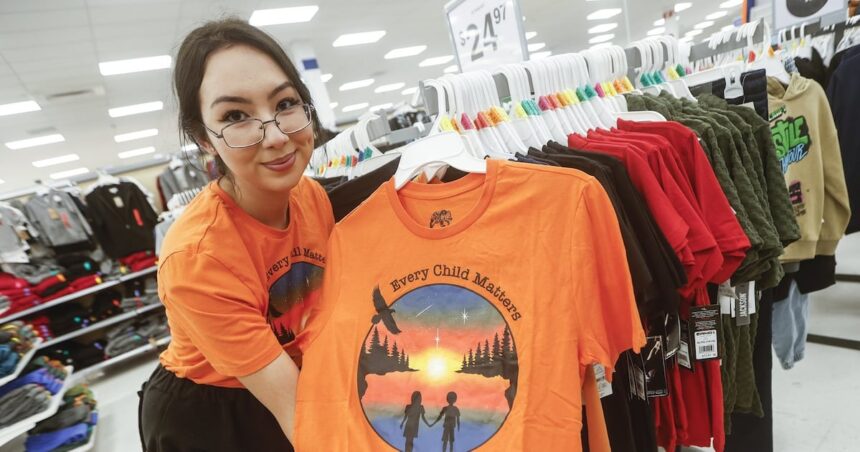The familiar orange hue that marks September 30th has become increasingly visible across Canadian storefronts and online retailers, as major corporations partner with Indigenous artists to commemorate National Day for Truth and Reconciliation. What began as a grassroots movement has evolved into a nationwide observance, creating both opportunities and complexities for Indigenous creators whose designs now appear on everything from t-shirts to coffee cups.
“These partnerships represent a double-edged sword,” explains Métis artist Caroline Monnet, whose distinctive geometric patterns are featured in a national retailer’s Orange Shirt Day collection this year. “There’s the opportunity to amplify Indigenous voices and stories, but also legitimate concerns about commodification and whether these collaborations truly benefit our communities.”
The movement stems from Phyllis Webstad’s story of having her new orange shirt taken away on her first day at residential school—a powerful symbol that has resonated across Canada as the country grapples with its historical treatment of Indigenous peoples. As Orange Shirt Day evolved into a federally recognized day of remembrance, corporate interest has grown substantially, with sales of orange-themed merchandise increasing approximately 230% over the past three years, according to retail analytics firm MarketTrack Canada.
Major retailers including Hudson’s Bay, Roots, and several financial institutions have launched Indigenous-designed merchandise with varying approaches to profit-sharing and community support. The most successful models involve direct collaboration with Indigenous artists, transparent revenue distribution, and concrete commitments to supporting Indigenous-led organizations working toward reconciliation.
Kyle Polson, a Cree artist from Saskatchewan whose designs are featured in three national campaigns this year, emphasizes the importance of Indigenous control in these partnerships. “When done right, these collaborations amplify our voices rather than speaking for us,” Polson told CO24 News. “I carefully evaluate each opportunity based on how much creative control I maintain and where the proceeds will go.”
Indigenous advocacy groups maintain that corporate participation must extend beyond seasonal merchandise to have lasting impact. “We encourage consumers to look beyond the orange shirt itself to the company’s year-round commitment to Indigenous communities,” says Melanie McLeod, executive director of the Indigenous Business Network. “Are they sourcing from Indigenous suppliers? Do they have Indigenous representation in leadership? These practices matter more than a single campaign.”
The significance of Orange Shirt Day merchandise extends beyond retail strategy to education and awareness. Many partnerships include QR codes linking to educational resources about residential schools, or include artist statements explaining the symbolism behind designs. A CO24 survey found that 68% of Canadians who purchased Orange Shirt Day items in 2024 reported learning something new about residential schools through materials accompanying their purchase.
For Indigenous communities, the expanding reach of Orange Shirt Day brings both visibility and concerns about exploitation. “Some companies are doing this work in a good way, with respect and proper protocols,” notes Elder Marion Crowe from Piapot First Nation. “Others are simply orange-washing—using our trauma for profit without meaningful connection to reconciliation.”
As Orange Shirt Day approaches, consumers are increasingly scrutinizing companies’ approaches. Social media campaigns encouraging shoppers to “buy Indigenous” have gained traction, highlighting Indigenous-owned businesses selling Orange Shirt Day merchandise with direct community benefits. According to CO24 Business analysis, Indigenous-owned retailers have seen a 45% increase in orange shirt sales compared to last year.
The Canadian government has also recognized the importance of economic reconciliation, with Indigenous Services Canada launching initiatives to support Indigenous entrepreneurs navigating increased demand around commemorative events. “Economic opportunities must be balanced with cultural respect,” states Minister Patricia Greene. “We’re working to ensure Indigenous creators benefit appropriately from the growing awareness.”
As Canadians prepare to mark another National Day for Truth and Reconciliation, the question remains: How can we honor the day’s solemn purpose while ensuring Indigenous communities truly benefit from increased commercial interest? Perhaps the answer lies not just in what we wear on September 30th, but in how we carry those lessons forward throughout the year.










